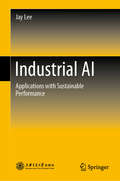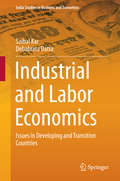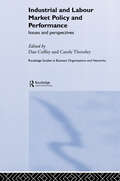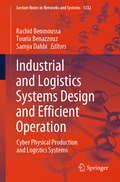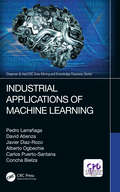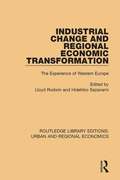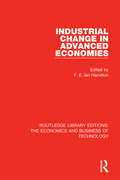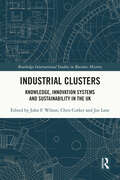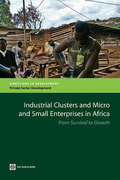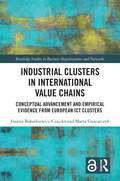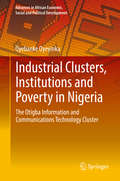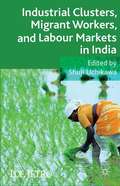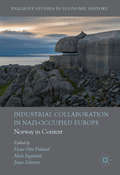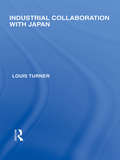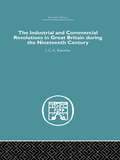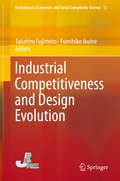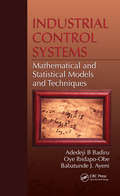- Table View
- List View
Industrial AI: Applications with Sustainable Performance
by Jay LeeThis book introduces Industrial AI in multiple dimensions. Industrial AI is a systematic discipline which focuses on developing, validating and deploying various machine learning algorithms for industrial applications with sustainable performance. Combined with the state-of-the-art sensing, communication and big data analytics platforms, a systematic Industrial AI methodology will allow integration of physical systems with computational models. The concept of Industrial AI is in infancy stage and may encompass the collective use of technologies such as Internet of Things, Cyber-Physical Systems and Big Data Analytics under the Industry 4.0 initiative where embedded computing devices, smart objects and the physical environment interact with each other to reach intended goals. A broad range of Industries including automotive, aerospace, healthcare, semiconductors, energy, transportation, mining, construction, and industrial automation could harness the power of Industrial AI to gain insights into the invisible relationship of the operation conditions and further use that insight to optimize their uptime, productivity and efficiency of their operations. In terms of predictive maintenance, Industrial AI can detect incipient changes in the system and predict the remains useful life and further to optimize maintenance tasks to avoid disruption to operations.
Industrial and Labor Economics
by Saibal Kar Debabrata DattaThis book is an attempt to capture and analyze several idiosyncratic features of industry and labor in the developing world. Available books and graduate-level texts in labor economics largely discuss industrial and labor market situations prevalent in developed countries, where well-defined institutional arrangements and regulations create a very different scope of analysis. The patterns of choice in training and contracts in the labor market more apparent in developing and transition countries are discussed, as are the information-theoretic results. The book also critically examines labor migration, a context in which the developing and transition countries represent large sources in the present global order. A broad base of empirical observations from industries is used to develop analytical conjectures on risk-sharing arrangements between workers and employers, while strong intuitive explanations are combined with relevant mathematical and graphical derivations, ensuring the book's readability among graduate students pursuing courses in labor economics and industrial economics for developing and transition countries. The book may also serve as a valuable reference guide for all students in advanced human resources courses at management schools. Presenting state-of-the art research findings in all of its chapters, the book discusses numerous institutional peculiarities of the developing world, making the results distinct in view of the general scope of labor economics.
Industrial and Labour Market Policy and Performance: Issues and Perspectives (Routledge Studies in Business Organizations and Networks #Vol. 26)
by Dan Coffey Carole ThornleyIndustrial issues are often inextricably linked with labour market concerns and policy approaches that attempt to consider production and employment separately are inherently flawed."This controversial statement sums up the heart of this important book. With contributions from such scholars as Keith Cowling, Malcolm Sawyer and Michael Kitson, Industrial and Labour Market Policy and Performance covers such topics as:* the increasing inequality between rich and poor* the links between innovation, competition and collaboration* education, skills formation and human resource managementThe evidence-led nature of the book will make it an important and useful read for students and academics involved in labour economics, industrial economics and industrial policy. The controversial findings of many of the chapters and its readable style will also appeal to informed policy commentators as well as policy-makers themselves.
Industrial and Logistics Systems Design and Efficient Operation: Cyber Physical Production and Logistics Systems (Lecture Notes in Networks and Systems #1332)
by Rachid Benmoussa Touria Benazzouz Samya DahbiThis book aims to provide recent achievements in the efficient design and operation of industrial and logistics systems. To achieve excellence, digital transformation is currently an essential path for systems reengineering. This path is still in an exploratory phase for industrial and logistics systems, as they cover a wide range of sectors and are composed of several complementary views.Thus, this book reconciles classic methods with modern ones based on digital transformation and Industry 4.0 technologies, which aim to optimize, improve, restructure, and evaluate a broad scope of systems, focusing on their four complementary views: operational, informational, technological, and decisional.It is intended for researchers and postgraduates in industrial engineering and logistics, professionals in senior management positions in industrial and logistics companies, as well as undergraduates in industrial and logistics engineering programs.
Industrial and Organizational Psychology: Research and Practice
by Paul SpectorThe field of industrial and organizational psychology continues to see attention and growth and has become one of the major applied specialties in the study of psychology. Since findings from research in this field are relevant to everyone who has held a job, and the field has developed proven methods that businesses and organizations need, industrial and organizational psychology is an excellent demonstration of how society can benefit from the study of psychology. The 6th Edition of Industrial and Organizational Psychology incorporates all new and updated literature that has been written on the topic since the 5th edition. Spector's goal is to provide an overview and comprehensive understanding of organizational psychology. Each of the major areas that comprise industrial and organizational psychology is covered in five parts: introduction to the discipline; assessment of jobs, performance, and people; selecting and training employees; the individual and the organization; and the social context of work.
Industrial Applications of Machine Learning (Chapman & Hall/CRC Data Mining and Knowledge Discovery Series)
by Carlos Esteban Puerto-Santana Pedro Larrañaga David Atienza Javier Diaz-Rozo Alberto Ogbechie Concha BielzaIndustrial Applications of Machine Learning shows how machine learning can be applied to address real-world problems in the fourth industrial revolution, and provides the required knowledge and tools to empower readers to build their own solutions based on theory and practice. The book introduces the fourth industrial revolution and its current impact on organizations and society. It explores machine learning fundamentals, and includes four case studies that address a real-world problem in the manufacturing or logistics domains, and approaches machine learning solutions from an application-oriented point of view. The book should be of special interest to researchers interested in real-world industrial problems. <P><P>Features <li>Describes the opportunities, challenges, issues, and trends offered by the fourth industrial revolution <li>Provides a user-friendly introduction to machine learning with examples of cutting-edge applications in different industrial sectors <li>Includes four case studies addressing real-world industrial problems solved with machine learning techniques <li>A dedicated website for the book contains the datasets of the case studies for the reader's reproduction, enabling the groundwork for future problem-solving <li>Uses of three of the most widespread software and programming languages within the engineering and data science communities, namely R, Python, and Weka
Industrial Art Explained (John Gloag On Industrial Design Ser.)
by John GloagOriginally published in 1934 this book became recognised as one of the principal standard works on industrial design and industrial architecture. The chapters explain the complete operation, character and background history of industrial art, its relation to architecture, materials, industrial production and retail distribution. It is fully illustrated with line drawings and photographs.
Industrial Aviation Management: A Primer in European Design, Production and Maintenance Organisations
by Martin HinschThis book outlines the structure and activities of companies in the European aviation industry. The focus is on the design, production and maintenance of components, assemblies, engines and the aircraft itself. In contrast to other industries, the technical aviation industry is subject to many specifics, since its activities are highly regulated by the European Aviation Safety Agency (EASA), the National Aviation Authorities and by the aviation industry standard EN 9100. These regulations can influence the companies’ organization, personnel qualification, quality management systems, as well as the provision of products and services. This book gives the reader a deeper, up-to-date insight into today's quality and safety requirements for the modern aviation industry. Aviation-specific interfaces and procedures are looked at from both the aviation legislation standpoint as well as from a practical operational perspective.
The Industrial Base for Carbon Dioxide Storage: Status and Prospects
by David S. Ortiz Constantine Samaras Edmundo Molina-PerezIf policies aimed at large reductions of carbon dioxide (CO2) emissions are enacted, more carbon capture and storage will be needed. RAND researchers explored the ability of the industrial base supporting the transportation and sequestration of CO2 to expand, assessing the industrial base for transportation and injection of CO2 for both geologic storage and enhanced oil recovery.
Industrial Britain Under the Regency: The Diaries of Escher, Bodmer, May and de Gallois 1814-18
by W.O. HendersonIn this book W. O. Henderson has brought together in English translation the journals of four foreign visitors who travelled in England and Scotland in the years immediately following the Napoleonic wars, in a way which may be regarded as a sequel to his recent book on J. C. Fischer’s diaries of industrial Britain. Two of the travellers whose journals are included in this volume were Swiss industrialists. Hans Caspar Escher was both a professional architect and the founder of the famous engineering firm of Esther Wyss of Zürich, Bodmer, also of Zürich, lived in England for many years and was recognised as an inventor of genius. The other accounts of industrial Britain in the Regency era are a report by the Prussian Factory Commissioner May and a short survey of the Newcastle upon Tyne colliery railways by the French government engineer Louis de Gallois. The four diaries show how informed foreign visitors were impressed by the way in which Britain had survived the perils of Napoleon’s Continental System and was now forging ahead to consolidate her position as the workshop of the world. This book was first published in 1968.
Industrial Buyer Behavior
by E. Raymond CoreyMay be used as background material for courses in industrial marketing and industrial procurement. Surveys the economic, behavioral, and organizational influences that shape buying decision-making in corporations and other institutions. Also describes the kinds of strategies purchasing groups formulate for dealing with their suppliers and supply environments.
Industrial Change and Regional Economic Transformation: The Experience of Western Europe (Routledge Library Editions: Urban and Regional Economics)
by Lloyd Rodwin Hidehiko SazanamiOriginally published in 1991. This book deals with industrial and regional changes in Western Europe and the effectiveness of policies designed to cope with them. It examines the regional experiences, including successes as well as problems, to illuminate the trends and policies; raises questions about the issues; and reports on the effects and further implications for not just Europe but Japan and many newly industrializing countries. Analysing the evolution and effectiveness of local, regional, national and European policies, this is of interest for industrial and development specialises as well as economists, planners, geographers and policy makers.
Industrial Change in Advanced Economies (Routledge Library Editions: The Economics and Business of Technology #17)
by F. E. Ian HamiltonOriginally published in 1987 and taking a review of the theories and processes of industrial relocation as its starting point, this book examines the nature of organisational and technologcal changes in detail and concludes with a series of industry case studies drawn from areas throughout the world. The book examines the salient features and implications of the reorganisation of industries and industrial enterprises, reflecting their development or harnessing of technological changes - not least ot increase their bargaining power with, control over, or use of labour. Various chapters discuss policy-making and the role of the State posed by the speed, scale and character of the changes.
Industrial Clusters: Knowledge, Innovation Systems and Sustainability in the UK (Routledge International Studies in Business History)
by John F. WilsonIndustrial Clusters shows the latest state of knowledge on the topic of industrial clusters, with a particular focus on clustering in the UK, bringing together a chronological coverage of the phenomenon. This set of original essays by a group of leading business and industrial historians offers fresh perspectives about clusters and clustering. A primary emphasis of the collection is how knowledge is generated and disseminated across a cluster, and whether these processes stimulated innovation and consequently longer-term sustainability. This analysis also prompts questions about which unit of analysis to examine, from the entrepreneurs and firms they created through to the industry as a whole and district in which they are located, or whether one should look outside the region for explanatory factors. Covering regions as diverse as North Wales, the Scottish Highlands, the City of London, the Potteries, Sheffield and Lancashire, the essays have been channelled to provide a detailed understanding of these issues. The editors have also provided a challenging Conclusion that suggests a new research agenda that could well unravel some of the mysteries associated with clustering. This edited collection will be of interest to international researchers, academics and students in the fields of business and management history, innovation, industrialisation and clusters.
Industrial Clusters and Micro and Small Enterprises in Africa
by World BankThe World Bank, Japan International Cooperation Agency (JICA) Research Institute, and the Foundation for Advanced Studies on International Development (FASID), in collaboration with researchers affiliated with the African Economic Research Consortium (AERC), recently conducted a study on Africa's domestic enterprises to improve the understanding of the constraints micro and small enterprises in Africa face in improving productivity and expanding their markets. In Africa, there are stark performance gaps between domestically owned enterprises and foreign-owned enterprises in terms of sales performance, productivity, and ability to reach distant markets. Among others, size appears to be a dominant factor in explaining the gap. Against this background, the study analyzes how naturally formed industrial clusters-concentrations of enterprises engaged in same or closely related industrial activities in specific locations-could potentially mitigate constraints Africa's micro and small enterprises face and enhance their business performance. The study is one of the first comprehensive quantitative inquiries on industrial clusters in Africa. The analysis specifically focuses on the role of spontaneously grown clusters of light manufacturing industries based on a set of original case studies of industrial clusters conducted for this research project. One of the key findings from the case studies was that cluster-based micro and small enterprises are performing better than similar micro and small enterprises outside of the clusters in terms of sales performance and ability to reach distant markets. Market access is a leading reason for cluster-based enterprises to choose their current locations. However, cluster-based enterprises face another set of unique growth constraints. By the very nature of spontaneous agglomeration, new enterprises continue to flow to the clusters seeking the profit opportunities and better access to markets at such locations. The result can be intense competition in addition to increased congestion. Space constraints often impede growth within clusters. The lack of alternative locations available for industrial activities in the same cities, generic infrastructure bottlenecks, and unclear zoning policies and their unpredictable changes limit firms' location choices and constrain their mobility. While competition should improve efficiency, lack of capacity among those competing cluster-based enterprises to invest and innovate does not generate growth out of the competition. The vast majority of naturally formed clusters of light manufacturing industries in Africa are still at a "survival" level, where agglomeration externalities are only limited to expand quantity but not quality as we observe in more advanced innovation-oriented clusters in elsewhere in the world. Existing studies on such natural industrial clusters in Africa have found that the lack of managerial skills among entrepreneurs running micro and small enterprises is a major constraint for innovation and growth in the clusters. As a part of this study, pilot managerial skills training programs were conducted in two industrial clusters on an experimental basis, where a group of randomly selected entrepreneurs within the clusters were given three-week long crush course of based management such as bookkeeping, marketing, business planning, and production management. The impact evaluation of the experiments showed significant positive impacts of the training programs on value added and gross profits of enterprises. Raising the current survival-type industrial clusters, which have been formed as a coping mechanism to weak investment climate, into more dynamic innovating clusters will be an important avenue for fostering growth of micro and small enterprises in Africa. While national efforts to improve investment climate and investments in human capital are undoubtedly important, there could be more targeted policies to be formulated, in complementing general policies, to support growth of micro and small domestic enterprises using exi...
Industrial Clusters in International Value Chains: Conceptual Advancement and Empirical Evidence from European ICT Clusters (Routledge Studies in Business Organizations and Networks)
by Marta Gancarczyk Joanna Bohatkiewicz-CzaickaClusters are considered crucial nodes in the ongoing transformation of international value chains (IVCs). Due to technological advancements and external shocks, such as pandemic and political conflicts, value chains (VCs) have been spatially and functionally shortening, and clusters are well suited to address the resulting demand for more diversified and higher value-adding activities in geographical proximity, such as European economic area. However, clusters differ in their positions and capability to advance in IVCs, which induces the research problem of the conditions for cluster upgrading (CU). This monograph aims to develop a theoretical framework for regional CU and empirically verify this framework based on ICT clusters in Europe. It advances the theory of upgrading by linking the VC governance and capability approaches, broadening the empirical evidence on the conditions of CU, and providing policy recommendations. The unique value of the findings from research and practice results in the identification of the determinants for CU and conceptualizes them into new theoretical constructs of the sufficient Framework Conditions and the necessary and sufficient Public-Private Knowledge Governance. Our empirical basis is European clusters in ICT, an industry being one of the Key Enabling Technologies (KETs) for innovation and VC transformation.The Open Access version of this book, available at http://www.taylorfrancis.com, has been made available under a Creative Commons Attribution-Non Commercial-No Derivatives (CC-BY-NC-ND) 4.0 license.
Industrial Clusters, Institutions and Poverty in Nigeria
by Oyebanke OyeyinkaThis book provides a systematic examination of the relationship between industrial clusters and poverty, which is analyzed using a multidimensional framework. It examines the often-neglected concept of social protection as a means of mitigating the risks and vulnerabilities faced by workers and citizens in poor countries. By analyzing the case of the Otigba Information and Communications Technology cluster in Lagos, Nigeria, the author shows under which conditions firms in productive clusters can pass on benefits to workers in ways that improve their living standards in the wider socio-economic and spatial context of the region. The results presented provide substantial evidence of opportunities for economic development, helping planners to explore different avenues for integrating firm-driven social protection into social policy.
Industrial Clusters, Migrant Workers, and Labour Markets in India
by Shuji UchikawaThis book analyzes three points: employment conditions for migrant workers, the impact of industrialization as part of industrial clusters upon surrounding and outlying villages, and the labour market in industrial clusters. This book examines the cases of two newly developed industrial clusters: Ludhiana in Punjab and Tiruppur in Tamil Nadu.
Industrial Collaboration in Nazi-Occupied Europe
by Hans Otto Frøland Mats Ingulstad Jonas SchernerThis book bringstogether leading experts to assess how and whether the Nazis were successful infostering collaboration to secure the resources they required during World WarII. These studies of the occupation regimes in Norway and Western Europe revealthat the Nazis developed highly sophisticated instruments of exploitationbeyond oppression and looting. The authors highlight that in comparison to theheavy manufacturing industries of Western Europe, Norway could provide many rawmaterials that the German war machine desperately needed, such as aluminium,nickel, molybdenum and fish. These chapters demonstrate that the Nazis providedincentives to foster economic collaboration, hoping that these would make everymine, factory and smelter produce at its highest level of capacity. All readerswill learn about the unique part of Norwegian economic collaboration duringthis period and discover the rich context of economic collaboration acrossEurope during World War II.
Industrial Collaboration with Japan (Routledge Library Editions: Japan)
by Louis TurnerThis study looks at the experiences of European and American companies that have collaborated with their Japanese competitors in the fields of computers, consumer electronics, automobiles and aero-engines, by forming joint ventures, designing products together and pursuing complementary marketing strategies. It examines why these companies have chosen to collaborate rather than compete; whether the Japanese companies have proved to be reliable partners; whether the non-Japanese have been left behind; and what the future of such collaboration may be. The book concludes by pointing to a growing interest among non-Japanese companies in investing and collaborating within Japan itself.
The Industrial & Commercial Revolutions in Great Britain During the Nineteenth Century
by L.C.A KnowlesFirst Published in 2005. Routledge is an imprint of Taylor & Francis, an informa company.
Industrial Competitiveness and Design Evolution (Evolutionary Economics and Social Complexity Science #12)
by Takahiro Fujimoto Fumihiko IkuineThis book integrates the concept of design into the existing framework of industrial performance, international trade and comparative advantage in trade and industrial phenomena, which increasingly have been affected by design characteristics of tradable goods. Design, capability and their evolution are introduced into current theories of trade to explain the reality of international trade in the early twenty-first century and the possibility of design-based comparative advantage is explored. Toward that end, the concepts of design, architecture, organizational capability and productivity are introduced, as are their interactions and evolution. The author starts from the fact that firms’ selection of design locations precedes that of production locations and that a new product’s initial production location is usually the same as its design location. In other words, design matters in explaining today’s trade phenomena. Thus, this book analyzes product design and its evolution in the context of the comparative advantage theory. The author argues that the concept of Ricardo’s comparative advantage must be reinterpreted in a more dynamic way than in the past, with changing labor input coefficients treated as variables and driven by international capability-building competition between factories. Some of the many topics dealt with in this volume include a capability-architecture view of industrial comparative advantage, a design-based view of manufacturing, the evolution of manufacturing capabilities, Ricardian comparative advantage with changing labor input coefficients, comparative design cost and selection of design locations and a design process model behind comparative design cost. In this way, the behaviors of factories, product development projects, firms, industries and national economies in today’s global competition are described and analyzed in the most realistic way.
Industrial Conflict in Britain
by S.W. Creigh Eric Wyn EvansFirst Published in 1977. Routledge is an imprint of Taylor & Francis, an informa company.
Industrial Consultancy: Operational Focus
by Sanjay SharmaThis book provides an in-depth analysis of industrial consultancy on a variety of issues and aspects including operations and services. This book: Looks at both individual-level consultancy and consultancy for firms, companies, or institutions. Uses observations, examples, and case studies to bring together key themes: consulting approach; production operations vs. services consulting; location and facilities criteria; human–machine interaction; lead time objective; outsourcing decisions and management; and infrastructure influence along with consultancy objectives, strategic considerations, and conflict resolution. Presents a comprehensive understanding of industrial consultancy and services offered to a wide range of industries, across type, size, and scale, including manufacturing, pharmaceutical, fabrication, and transformer industries. The first of its kind, this book will be a useful resource for industry and management professionals as well as scholars and researchers of business management, business economics, operations, entrepreneurship and organizational behaviour, and engineering.
Industrial Control Systems: Mathematical and Statistical Models and Techniques (Systems Innovation Book Series)
by Adedeji B. Badiru Oye Ibidapo-Obe Babatunde J. AyeniIssues such as logistics, the coordination of different teams, and automatic control of machinery become more difficult when dealing with large, complex projects. Yet all these activities have common elements and can be represented by mathematics. Linking theory to practice, Industrial Control Systems: Mathematical and Statistical Models and Techni
